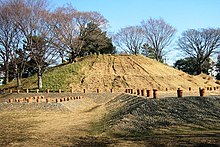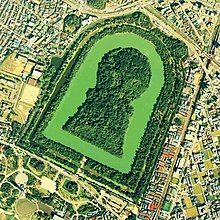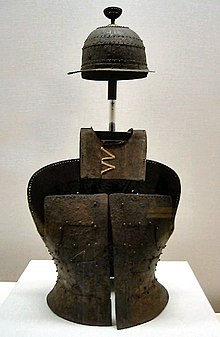Kofun time
The Kofun period ( Japanese 古墳 時代 , kofun-jidai ) is a period in Japanese history that extends from around 300 to 538 AD. It forms the first half of the Yamato period . The eponymous large key tombs originate from this time . There was close political contact with neighboring Korea and immigration from Korea to Japan. From the 5th century onwards, the Chinese script was adopted and adapted .
Time limit
The temporal delimitation of epochs in early history is usually fraught with a certain arbitrariness and blurring. Since the demarcation of the Kofun period is attached to the barrows (" Kofun ") that are characteristic of it, it begins somewhere in the second half of the 3rd century, from which the first such tombs were known, and ends in 538 as the Kofun fell out of use by the ruling families. Nevertheless, kofun were still established throughout the following Asuka period . This is why the end of the Kofun period (including the Asuka period) is occasionally given as the year 710.
Overview
The unified Japan in the Kofun period began in the fertile Kinai plain . The period got its name from the keyhole-shaped tombs ( 古墳 kofun ) of the rulers.
Around the year 400 there was a center of power in the province of Yamato (now Nara prefecture ), which, however, had not yet extended its influence to the Kantō plain , the Tōhoku region and Hokkaidō . This time saw an intensive exchange with China. Both the Chinese script and religious ideas ( Buddhism , Confucianism , Daoism ) gradually found their way to Japan in the 4th and 5th centuries . Under a sometimes only representative Tennō (emperor), political power was largely in the hands of the Soga family , who promoted Buddhism. Not only Buddhism, but also the centralization of the state on the Chinese model was sought by the Soga. The Chinese calendar was introduced. In the 7th century, Soga rule was brutally ended by rival families.
There were close political and military contacts with the Korean Gaya Federation (also known as Mimana ). Gaya was conquered by the Korean kingdom of Silla in 562 AD .
Kofun burial mound
The burial mounds, called Kofun , contained large stone burial chambers. Some of the hills were surrounded by ditches. In the late period, the typical burial chambers, which were originally only intended for the ruling class, were also created for people from the common people. Kofun burial mounds were built in many forms. The simplest shapes were circles or squares. A special shape is the keyhole shape ( zempō kōen ), with a square hill in front and a round hill behind it. Many of the burial mounds were originally natural mounds that may have been remodeled to their final shape. Kofun vary in size from a few meters to over 400 m in length.
The largest tombs are believed to be those of Emperors Ōjin and Nintoku . Kofun are classified according to whether the entrance to the stone burial chamber is vertical ( tate-ana ) or horizontal ( yoko-ana ) (see also article Kofun ).
Society during the Kofun period
During the Kofun period, a feudal society developed with militaristic rulers. The cavalry was armed with armor, swords, and other weapons, and employed advanced tactics common in what was then Northeast Asia. Progress in this area can be seen in grave figures, the so-called haniwa . That literally means clay rings. They have been found in thousands of kofun scattered across Japan. The most important haniwa were found in southern Honshu, especially in the Kinai area around Nara and in northern Kyushu. Haniwa grave goods had numerous different shapes such as animal figures in the form of horses, chickens, birds, pheasants or fish, or shapes of objects such as houses, weapons, shields, parasols, pillows or human figures in the form of men and women. Another burial object, the magatama , became one of the symbols of power in the imperial house. Many of the cultural objects from this period can hardly be distinguished from contemporary objects from the southern Korean peninsula. This suggests that Japan was in close political and economic contact with mainland Asia through Korea at the time. In fact, bronze mirrors have been found in both Japan and Korea that were cast in the same mold.
The Kofun period was an important phase in the evolution towards a cohesive and recognizable state. The society was most developed in the Kinai region and the easternmost part of the Inland Sea ( Seto Inland Sea ). The Japanese rulers even asked the Chinese court to confirm the royal titles.
The Yamato social order, which emerged in the late fifth century, was characterized by powerful and extensive extended families, including their followers. Each extended family was led by a patriarch who performed sacred rites in honor of the family's kami to ensure the family's long-term well-being. The family members were the nobles, and at the top was the royal family line that controlled the Yamato court. The Kofun period is also referred to by some Western scholars as the Yamato period , as this local tribal order developed into the imperial dynasty towards the end of the Kofun period. Japanese archaeologists, on the other hand, emphasize the fact that in the first half of the Kofun period other regional chiefs such as the Kibi also competed for supremacy near what is now Okayama .
Introduction of Buddhism
In the late Kofun period there was a lively cultural exchange with mainland Asia. Buddhism was adopted from Korea , probably in 538. This exposed Japan to a new religious doctrine. The Soga , a courtly Japanese family that came to prominence with the accession of Emperor Kimmei to the throne in 531, promoted the adoption of Buddhism as well as government practices and cultural models based on Chinese Confucianism . But some at the Yamato court, such as the Nakatomi family and the Mononobe family, insisted on traditional traditions and refused to embrace the new Buddhism. This is explained in the case of the Nakatomi family, who later also became known as Fujiwara , with the fact that they were entrusted with performing the Shinto rituals and did not want to forego the influence that was based on them. The Soga introduced tax practices based on the Chinese model and established the first national treasury. Bitterness reigned for more than a hundred years between the Soga on the one hand and the Nakatomi and Mononobe on the other, with the Soga temporarily gaining the upper hand.
The Kofun period is believed to have ended in 538 when the use of the ornate kofun by the Yamato family and other ruling families became out of fashion because of the new Buddhist beliefs. This emphasized the passage character of human life. The common people and nobles in remote areas built Kofun burial mounds until the late seventh century, and more simple and differently designed burial mounds continued to be built in the following period. The Asuka period follows the Kofun period .
See also
literature
- Anonymous: Kofun period culture of the Kanto and Kinki regions. Collections of Tenri University Sankokan (Tenri Gallery Exhibition; Vol. 129). Tenri Galleries, Tokyo 2006.
- Anonymous: The Kofun period or the time of the ancient graves . In: Getty Images (ed.): On the trail of sunken empires. Splendor and mystery of great cultures (“Historia de la humidad”, 2000). Lingen-Verlag, Cologne 2005, pp. 487-488.
- Gina L. Barnes: Yayoi-Kofun settlement archeology in the Nara Basin, JApan . UMI Press, Ann Arbor, Mich. 1983 (2 vols.).
- Kenneth G. Henshall: The early state emerges. The Kofun / Yamoto Period (approx. 300-710) . In: Ders .: A history of Japan. From stone age to superpower . St. Martin's Press, New York 1999, pp. 11-17, ISBN 0-312-21986-5 .
- Josef Kreiner: Kofun barrows. Issues of Ethnogenesis . In the S. (Ed.): Brief history of Japan . Reclam, Stuttgart 2010, pp. 39-42, ISBN 978-3-15-010783-6 .
- Samuel J. Lurie et al. a .: Fired with passion. Contemporary Japanese Ceramics . Eagle Art Publ., New York 2006, ISBN 1-89164-038-0 .
- Penelope Mason: The birth of Japan. The Jomon and Yayoi periods and Kofun era . In: Diess .: History of Japanese Art . Abrams Books, New York 1993, ISBN 0-8109-1085-3 .
- Koji Mizoguchi: An archaeological history of Japan. 30,000 BC to 700 AD . University Press, Philadelphia, Penn. 2002, ISBN 0-8122-3651-3 .
- Maria Shinoto: Ways of ceramic classification using the example of a prehistoric earthenware from southern Japan . Dissertation University of Heidelberg 2003.
- Hiroshi Tsude: Homogenity and regional variability in cultures of the Kofun Period . In: Keichi Omoto (ed.): International Symposium Interdisciplinary perspectives on the origins of the Japanese, September 25-28, 1996 . IRCJS, Tokyo 1996.
- Hiroshi Tsude: The Kofun Period and state formation . In: Acta Asiatica , Vol. 63 (1992), pp. 64-86, ISSN 0567-7254 .
- Hildja Y. Wittig: Megalithic graves in Yamato from three periods of the Kofun period. With an excursus on the Fujinoki-Kofun (between 560 and 590) . Hänsel-Hohenhausen Verlag, Egelsbach 1995, ISBN 3-8267-2070-9 .




